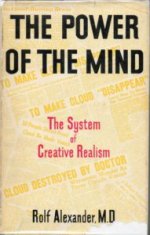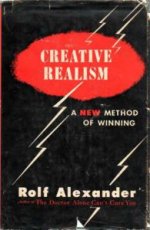Section
Rolf Alexander M.D.
First | Previous | Next | Last
The Power of the Mind - The System of Creative Realism (1954)
This Edition

| Published | 1956 | First edition | No |
| Format | Hardcover (232 x 157mm) | Edition | 1st UK |
| Publisher | T. Werner Laurie | Printing | |
| ISBN | Printed by | ||
| Country | UK | ||
| Series | No of pages | 248 | |
| Volume |
Notes
Originally published in the US as Creative Realism. A New Method of Winning (1954), this volume is better known by its UK title, The Power of the Mind -- The System of Creative Realism (1956) -- not to be confused with The Healing Power of the Mind by the same author.
Benjamin Creme states that this volume "is very interesting in that it provides a very simple process of self-hypnosis whereby you can free the mind from its fragmentation in the subconscious" (The Art of Living, p.158-59).
In his book Self-Suggestion and the New Huna Theory of Mesmerism and Hypnosis (HuNa Research Publications, CA, USA, 1958, p.38) Max F. Long writes: "Dr. Alexander offers the theory that we are all hypnotized to a considerable degree by what has happened to or around us in our lives. He seems to blame many of our personality troubles on this form of hypnosis-without-a-hypnotist, and he offers a method which he calls 'self-realization' to be used to dehypnotize ourselves. The use of this method is urged as a preliminary to the administering of autosuggestion. It is also to be used as an antidote to remaining in a suggestible trance to some extent after the use of autohypnosis."
In the Preface to his first book Benjamin Creme writes that "The magazine article which drew my attention to [The Power of the Mind], of course, concentrated on the most sensational aspect of the book -- 'cloud busting', the breaking up of clouds by the power of thought alone" (The Reappearance of the Christ and the Masters of Wisdom, p.12). Given Mr Creme's early interest in flying saucers, his reference is probably to an article by Dr Alexander in the November/December 1955 edition of the British Flying Saucer Review, titled 'Psychokinesis' (pp.8-10). Earlier that year, in the US, FATE magazine carried an article about Dr Alexander ('Rolf Alexander -- The Man Who Smashes Clouds') in its issue No.63 of June 1955 (pp.42-45), with photographs from the local Orillia Packet and Times newspaper.
This book contains the same photographs of the famous cloud-dispersal demonstration that Dr Alexander gave at the town of Orillia, Ontario, Canada on 12 September 1954, in the presence of representatives of the media and the mayor of Orillia. In the original US edition and the first UK edition these photographs are printed on the back of the dust jacket, while an additional set of 12 photographs is included in the book showing a cloud-dispersal demonstration which the author gave at Mexico City in January 1952, "before reliable and qualified witnesses", as well as an Appendix and a Bibliography, which are not included in later UK impressions, the fourth and last of which appeared in 1968. In the closing paragraph of the Appendix the author writes: "This present book is written as a training manual in the basic principles of Creative Realism, but other books are planned to carry on from where this one halts." (Another cloud-busting technique is described in Wilhelm Reich (1957), Contact With Space.)
Rolf Alexander M.D., a 1.8 degrees initiate (Share International No.1, Jan./Feb. 1995, p.31), was born on the American Clipper ship Luzon en route to New Zealand in 1891. He was taken by his parents to Canada as a boy, graduated in medicine in Prague and studied as a personal pupil of the Greek-Russian philosopher Gurdjieff in 1913. Around 1938 Dr Alexander travelled to India and on to Tibet where he stayed for one year as "the guest of an English-speaking abbot of a lamasery near Shigatze," according to the biographical information on the back flap of the original US and UK editions. In Chapter 12, in the paragraph 'The Lama', the writer describes one of the hands-on lessons in detachment from the physical body from this lama, whom Benjamin Creme has confirmed was the Master Djwhal Khul (see the notes for The Voice of Talking Valley).
No further biographical information about the author could be found, except for a reference in The UFO Encyclopedia (2nd ed. 1998, p.277) by Jerome Clark, who writes: "In 1956, England's Flying Saucer Review published startling revelations by a contributor identified only as a 'special correspondent.' The correspondent asserted that a highly placed American official had confided to him that UFOs were known to contain friendly space visitors who were trying to find a way to breathe Earth's atmosphere before landing and declaring themselves. The magazine revealed nine years later that its unnamed informant was one 'Rolf Alexander, M.D.,' and that the official was the late general and diplomat George C. Marshall [of Marshall Plan fame, Ed.]."
Clark continues: "It did not mention that 'Alexander' was in fact an ex-convict whose real name was Allan Alexander Stirling. 'Alexander' claimed vast psychokinetic powers that allowed him to break up clouds." According to Benjamin Creme, however, Rolf Alexander "was not Alexander Stirling, nor was he convicted of any crime." (Share International No.10, December 2007, p.27)
UFO researcher Timothy Good also mentions Dr Alexander in his book Alien Base.
See also:
Wilhelm Reich M.D. (1957), Contact with Space
Links
Original Edition

| Original title | Creative Realism |
| Original subtitle | A New Method of Winning |
| Original publication year | 1954 |
| Original publisher | Pageant Press |
| Original country | USA |
| Original language |